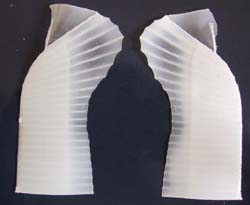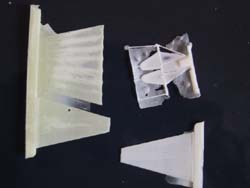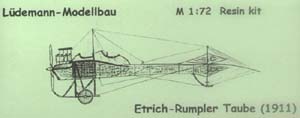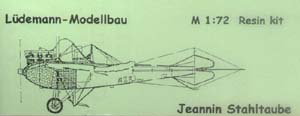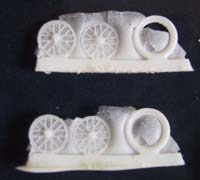Luedemann Modellbau 1/72 Resin
Etrich Rumpler Taube 1911
and Jeannin Stahltaube | | History One of the most famous CLASSES of aircraft before, and during, the First World War were the German and Austrian "Tauben". When the war started, the Tauben were the synonymous for German aircraft. They were the typical German aircraft depicted on propaganda leaflets of both sides. In real life, the Taubes were already being phased out when the war began, and by the end of the first year of the war they had basically disappeared from the front lines. The Taube designation , as already stated above, applied for a whole class of aircraft. They had their roots in the adoption of the planform of the dried seed of the Zanonia Macrocarpa plant, which was found to glide in a stable fashion. The Austrian pioneer Igo Etrich was the first to adopt (with his partner Franz Wels) that planform for a practical flying machine. The first successful Taube was flown in April 1910. It proved to be the most successful Austrian design up to that time, and at a time held ALL Austrian aeronautical records. A meeting between Etrich and Edmund Rumpler in Berlin in the same year set the stage for the licence production of the Taube in Germany. From that moment on, Taubes in their various forms became the most widely used pre war German and Austrian aircraft. One of the first products of the Etrich-Rumpler cooperation (which failed soon thereafter) was the 1911 model - THE classical Taube design with thin wings, bulbous fuselage nose containing engine and the two occupants, and a straight sided fuselage with a very long fin. The typical support girder below the wing was also there Many other designers soon jumped on the Taube bandwagon. One of them was the Alsatian aviation pioneer Emile Jeannin, who learned to fly in France in 1909. After some early successes during a brief episode with the Alsatian Aviatik Flugzeugwerke, in which his brother Henri held some interests, he founded (in February 1912) his own company in Johannistal, the mecca of German aviation at that time. After turning out a few conventional monoplanes, the first Stahltaube (the name coming from the fact that the aircraft had a steel tube fuselage, whereas the wings were of conventional wooden construction) appeared during the same year. Improved models were built in 1913 and 1914, with at least 37 built for the German military. The later model Stahltauben had some very functional looking fuselages with flat sides and did away with the underwing girders. However, their performance remained inadequate for 1914 standards, and they disappeared soon. Whereas Rumpler found other solutions for the Fliegertruppe requirements, bringing out a series of highly successful biplanes with good altitude performance, Emile Jeannin disappeared from the scene soon after the start of the war. Various reasons, both political (being an Alsatian with natural ties to France) and legal problems involving a young girl with influential parents have been given. The Jeannin Flugzeugbau transformed into the National Flugzeugwerke in May 1915. However, one aircraft of this small company survived the chaos of two World Wars. Once belonging to the "Deutsche Luftfahrtsammlung" in Berlin, it was stored and later rediscovered in Poland. Transferred back to Germany, the aircraft was restored to its former pride and can now be seen in Berlinīs Museum fuer Verkehr und Technik, one of the last examples of the once famous Taube brand. The kits Luedemann Modellbau is a brand new producer of resin kits specialising in early WW I aircraft, mainly German and Austro-Hungarian subjects. The man behind it all, Thomas Luedemann, has achieved something special: his kits (of which there are around 15 different types already) are as good or better than anything seen before, including the famous Czechmaszter kits. The two Taubes discussed here are typical for that series: Both come in small, but sturdy boxes typical for the distributor (the Modellbaustudio Rhein-Ruhr, also manufacturer of the Classic Plane kits). Both boxes contain around 50 pieces. Starting with the fuselage, they come as a main one piece moulding with a separate upper part for the cockpit area. the cockpit sidewalls include some of the finest details I have ever seen on a resin kit, while the sides are so thin that you can nearly see through them. Also some of the finer outside detail has to be seen to be believed. Next come the wings, a three-piece assembly for the Etrich-Rumpler and two pieces for the Jeannin. It is here that the kits really excel: I have NEVER seen anything like these wings. Taube wings are a very three dimensional affair with extremely thin trailing edges. Tha'ss something I have never seen before convincingly displayed, even in larger kits. The Luedemann versions are just simply PERFECT in this area. The trailing edges are so thin that you can see through. Under a thin coat of paint, this will result in the most convincing portrayal of a Taube wing. The same level of fineness is maintained with the fin and rudders. Turning to the detail parts, everything needed is there and carefully modelled. Some of the details like steering wheels, seats and radiators are thinner and more to scale than anything I have seen before. The Etrich Rumpler even includes resin molded spoked wheels, which (while maybe not as good as photo etched ones) look good enough to be used -I have seen a sample built and know what Iīm talking about. The kits come with some basic instructions and three view drawings. There are no decals included. Obviously, that level of detailing comes with some problems: The kits will need some very careful handling in order not to bend or break anything. Too, even small inadequacies in molding, bubbles etc are more plainly visible in the thin, unforgiving stuctures than in standard resin kits. Fortunately, the resin used in these kits looks very strong, and the kits that I have show no warping or misalignment at all. Conclusion It is difficult to describe these kits without running out of superlatives. The depiction of the wing structure is definitely the best I have ever seen. The detail parts, while fragile, are nearly perfect in their scale accuracy. There obviously are some molding problems, but Herr Luedemann obviously also has a good Quality Control installed. In all the kits I have are some imperfectly moulded parts, but for these parts there are also always some replacements included. Definitely some of the best 1/72 scale kits you can buy . Also definitely not for beginners. You will need some experience with early aircraft and simpler resin kits before starting one of these. One final advantage, when compared to some decidedly overpriced kits that can be found on the market today, are the very competitive prices for these kits.
Luedemann Modellbau kits are at this time only available through the
Modellbaustudio Rhein-Ruhr
| 


 



  
    |
